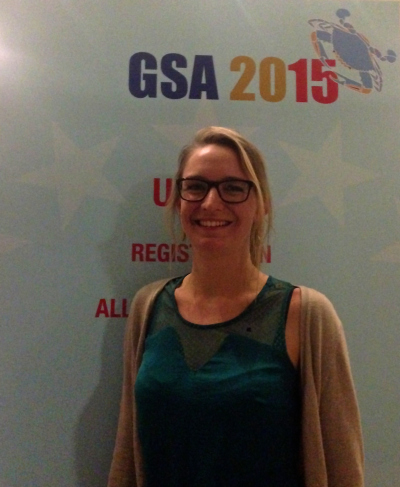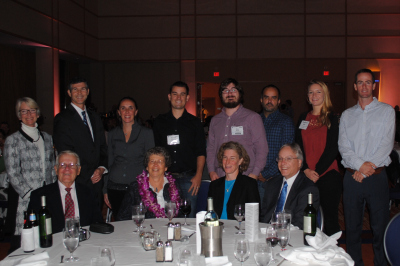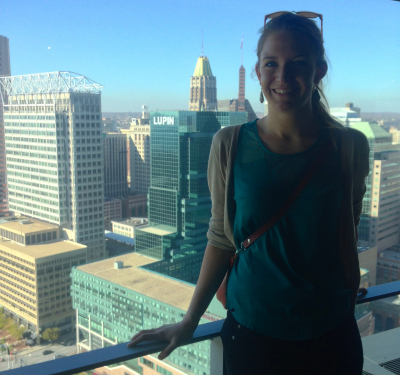Die Inhalte dieser Seite sind leider nicht auf Deutsch verfügbar.
Seitenpfad:
Marleen Stuhr
Report of GLOMAR PhD student Marleen Stuhr about her participation in the GSA 2015 Annual Meeting in Baltimore, Maryland, USA from 1 – 4 November 2015
The Annual Meeting of the Geological Society of America (GSA) engaged with topics related to all imaginable fields of geosciences. It did not only offer presentations in oral technical sessions, but also a wide range of field trips, poster sessions, social events, exhibits of industry, research institutions and other associations. The diversity of talks included coastal protection, sedimentology, paleontology, coral reef studies, as well as novel and cutting-edge topics ranging from the application of molecular biology in geosciences as well as remote sensing techniques and a special session on the recent Nepal (Gorkha) Earthquake.
With more then 7400 researchers and students from around the world attending the meeting, it was an impressive conference comprising several leading scientists in the field of foraminiferal research. Even though this is a conference mostly visited by American scientists, 58 countries were represented and I felt highly welcomed in this international atmosphere. The GSA 2015 held usually about 20 sessions running at the same time, so there was always something interesting to visit for everyone. Especially the sessions on marine and coastal sciences and the evening poster sessions with beer reception benefited of lively participants and fruitful discussions.
I started the meeting by attending one of the offered short-courses ‘How to talk to strangers: Selling Yourself and Your Science’. The course gave me the great opportunity to develop and practice an elevator speech, learn about how to get into contact with other researchers at conferences and already meet some other young scientists attending GSA 2015. During the meeting, I particularly benefitted from the sessions ‘Insights from Microfossils, from traditional to novel approaches’, which was a poster session, ‘Co-evolution of life and planet: broad-scale controls on biodiversity’, ‘Timing of the origins and evolution of unicellular eukaryotes’ and ‘Phanerozoic evolution in the oceans: effects of warming and chemical changes’ that all hosted very interesting and inspiring oral presentations related to the different fields I am working in during my PhD project. I presented a talk titled ‘Acclimatization potential of Amphistegina spp. And their symbionts to short- and long-term thermal stress’ in the session ‘Foraminiferal responses and recovery from environmental stressors’ on the 4th day of the conference. As this session sought to highlight mechanisms responsible for spatial, temporal and physiological responses to natural and anthropogenic environmental disturbances, many other researchers were present dealing with similar research questions and even with the same species I am working with. Thus, I received inspiring questions after my talk and feedback on the experimental design of the presented study. The questions asked is certainly going to be considered in the manuscript I am preparing. After the session I got into a discussion on further experiments and usage of new microscopic techniques I am going to test in the future.
Besides the pleasant social events offered during the conference such as the daily beer reception within the poster exhibition hall, I had the opportunity of participating at the Cushman foundation for foraminiferal research dinner reception, during which I received the Cushman student travel award. This was a great opportunity to meet and talk to several well-known scientists who are the best specialists for foraminifera and at the same time get to know many young scientists, working in projects related to mine and exchange experiences and discuss novel techniques. Moreover, some former academics were present who are now applying their knowledge of foraminifera working in governmental institutions or different kinds of industry, which opened my eyes to the variety of opportunities that will be waiting for me at the end of my PhD.
As the warm and sunny autumn weather in Baltimore acted as a catalyst for the friendly and open atmosphere, I really enjoyed the conference and the opportunity to meet and interact with several international scientists. Furthermore, I got to know more researchers who are working with Amphistegina gibbosa from the Florida Keys, as I do, who specialized on different environmental stressors and by different methodologies. This way, we could combine our results and got some new ideas. I also learned about a new staining method that keeps the foraminifera alive and allows observation of bleaching processes that are usually not visible to the human eye. I hope to use this soon in my project.
In general, participating in the GSA 2015 allowed me to strengthen my scientific network, learn about new approaches and improve my own research. Special thanks to GLOMAR and the Joseph A. Cushman foundation for supporting my participation in the GSA 2015.
With more then 7400 researchers and students from around the world attending the meeting, it was an impressive conference comprising several leading scientists in the field of foraminiferal research. Even though this is a conference mostly visited by American scientists, 58 countries were represented and I felt highly welcomed in this international atmosphere. The GSA 2015 held usually about 20 sessions running at the same time, so there was always something interesting to visit for everyone. Especially the sessions on marine and coastal sciences and the evening poster sessions with beer reception benefited of lively participants and fruitful discussions.
I started the meeting by attending one of the offered short-courses ‘How to talk to strangers: Selling Yourself and Your Science’. The course gave me the great opportunity to develop and practice an elevator speech, learn about how to get into contact with other researchers at conferences and already meet some other young scientists attending GSA 2015. During the meeting, I particularly benefitted from the sessions ‘Insights from Microfossils, from traditional to novel approaches’, which was a poster session, ‘Co-evolution of life and planet: broad-scale controls on biodiversity’, ‘Timing of the origins and evolution of unicellular eukaryotes’ and ‘Phanerozoic evolution in the oceans: effects of warming and chemical changes’ that all hosted very interesting and inspiring oral presentations related to the different fields I am working in during my PhD project. I presented a talk titled ‘Acclimatization potential of Amphistegina spp. And their symbionts to short- and long-term thermal stress’ in the session ‘Foraminiferal responses and recovery from environmental stressors’ on the 4th day of the conference. As this session sought to highlight mechanisms responsible for spatial, temporal and physiological responses to natural and anthropogenic environmental disturbances, many other researchers were present dealing with similar research questions and even with the same species I am working with. Thus, I received inspiring questions after my talk and feedback on the experimental design of the presented study. The questions asked is certainly going to be considered in the manuscript I am preparing. After the session I got into a discussion on further experiments and usage of new microscopic techniques I am going to test in the future.
Besides the pleasant social events offered during the conference such as the daily beer reception within the poster exhibition hall, I had the opportunity of participating at the Cushman foundation for foraminiferal research dinner reception, during which I received the Cushman student travel award. This was a great opportunity to meet and talk to several well-known scientists who are the best specialists for foraminifera and at the same time get to know many young scientists, working in projects related to mine and exchange experiences and discuss novel techniques. Moreover, some former academics were present who are now applying their knowledge of foraminifera working in governmental institutions or different kinds of industry, which opened my eyes to the variety of opportunities that will be waiting for me at the end of my PhD.
As the warm and sunny autumn weather in Baltimore acted as a catalyst for the friendly and open atmosphere, I really enjoyed the conference and the opportunity to meet and interact with several international scientists. Furthermore, I got to know more researchers who are working with Amphistegina gibbosa from the Florida Keys, as I do, who specialized on different environmental stressors and by different methodologies. This way, we could combine our results and got some new ideas. I also learned about a new staining method that keeps the foraminifera alive and allows observation of bleaching processes that are usually not visible to the human eye. I hope to use this soon in my project.
In general, participating in the GSA 2015 allowed me to strengthen my scientific network, learn about new approaches and improve my own research. Special thanks to GLOMAR and the Joseph A. Cushman foundation for supporting my participation in the GSA 2015.






